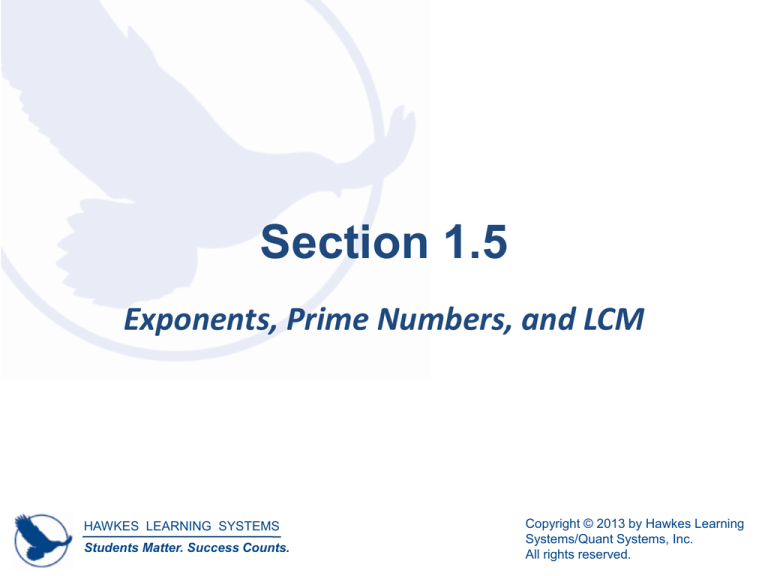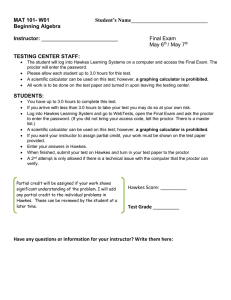
Section 1.5
Exponents, Prime Numbers, and LCM
HAWKES LEARNING SYSTEMS
Students Matter. Success Counts.
Copyright © 2013 by Hawkes Learning
Systems/Quant Systems, Inc.
All rights reserved.
Objectives
o Evaluate expressions with exponents.
o Recognize prime numbers less than 50.
o Determine the prime factorization of a composite
number.
o Find the LCM (least common multiple) of a set of
counting numbers.
HAWKES LEARNING SYSTEMS
Students Matter. Success Counts.
Copyright © 2013 by Hawkes Learning
Systems/Quant Systems, Inc.
All rights reserved.
Example 1: Writing Exponents
With Repeated Multiplication
With Exponents
a. 5 5 = 25
52 = 25
b. 2 2 2 = 8
23 = 8
c. 5 5 5 = 125
53 = 125
d. 10 10 10 10 = 10,000
104 = 10,000
HAWKES LEARNING SYSTEMS
Students Matter. Success Counts.
Copyright © 2013 by Hawkes Learning
Systems/Quant Systems, Inc.
All rights reserved.
Exponents
Exponent and Base
A whole number n is an exponent if it is used to tell
how many times another whole number a is used as a
factor. The repeated factor a is called the base of the
exponent. Symbolically,
exponent
a a a
a a an.
n factors
base
HAWKES LEARNING SYSTEMS
Students Matter. Success Counts.
Copyright © 2013 by Hawkes Learning
Systems/Quant Systems, Inc.
All rights reserved.
Exponents
COMMON ERROR
Do not multiply the base
and the exponent.
102 = 10 2 INCORRECT
63 = 6 3
INCORRECT
HAWKES LEARNING SYSTEMS
Students Matter. Success Counts.
Do multiply the base by
itself.
102 = 10 10 CORRECT
63 = 6 6 6 CORRECT
Copyright © 2013 by Hawkes Learning
Systems/Quant Systems, Inc.
All rights reserved.
Example 2: Translating Expressions with
Exponents
a. 82 = 64 is read “eight squared is equal to sixty-four.”
b. 53 = 125 is read “five cubed is equal to one hundred
twenty-five.”
Expressions with exponents other than 2 or 3 are read
as the base “to the ____ power.”
For example,
25 = 32 is read “two to the fifth power is equal to
thirty-two.”
HAWKES LEARNING SYSTEMS
Students Matter. Success Counts.
Copyright © 2013 by Hawkes Learning
Systems/Quant Systems, Inc.
All rights reserved.
Prime Numbers and Composite Numbers
Prime Numbers
A prime number is a counting number greater than 1
that has exactly two different factors (or divisors),
namely 1 and itself.
HAWKES LEARNING SYSTEMS
Students Matter. Success Counts.
Copyright © 2013 by Hawkes Learning
Systems/Quant Systems, Inc.
All rights reserved.
Prime Numbers and Composite Numbers
Composite Numbers
A composite number is a counting number with more
than two different factors (or divisors).
HAWKES LEARNING SYSTEMS
Students Matter. Success Counts.
Copyright © 2013 by Hawkes Learning
Systems/Quant Systems, Inc.
All rights reserved.
Example 3: Prime Numbers
Some prime numbers:
2
2 has exactly two different factors, 1 and 2.
3
3 has exactly two different factors, 1 and 3.
11
11 has exactly two different factors, 1 and 11.
29
29 has exactly two different factors, 1 and 29.
HAWKES LEARNING SYSTEMS
Students Matter. Success Counts.
Copyright © 2013 by Hawkes Learning
Systems/Quant Systems, Inc.
All rights reserved.
Example 4: Composite Numbers
Some composite numbers:
15
1, 3, 5, and 15 are all factors of 15.
39
1, 3, 13, and 39 are all factors of 39.
49
1, 7, and 49 are all factors of 49.
51
1, 3, 17, and 51 are all factors of 51.
HAWKES LEARNING SYSTEMS
Students Matter. Success Counts.
Copyright © 2013 by Hawkes Learning
Systems/Quant Systems, Inc.
All rights reserved.
Prime Numbers and Composite Numbers
Even and Odd Whole Numbers
If a whole number is divisible by 2, it is even.
If a whole number is not divisible by 2, it is odd.
HAWKES LEARNING SYSTEMS
Students Matter. Success Counts.
Copyright © 2013 by Hawkes Learning
Systems/Quant Systems, Inc.
All rights reserved.
Prime Factorization of Composite Numbers
To Find the Prime Factorization of a Composite
Number
1. Factor the composite number into any two factors.
2. Factor each factor that is not prime into two more
factors.
3. Continue this process until all factors are prime.
The prime factorization is the product of all the prime
factors.
HAWKES LEARNING SYSTEMS
Students Matter. Success Counts.
Copyright © 2013 by Hawkes Learning
Systems/Quant Systems, Inc.
All rights reserved.
Prime Factorization of Composite Numbers
Notes
You may have studied quick tests for divisibility by 2, 3,
5, 6, 9, and 10 in a previous course in mathematics. For
example, a number is divisible by 2, and therefore
even, if the units digit is 0, 2, 4, 6, or 8. We will make
reference to some of these tests for divisibility in the
examples. See the end of the section for a brief review
of this helpful topic.
HAWKES LEARNING SYSTEMS
Students Matter. Success Counts.
Copyright © 2013 by Hawkes Learning
Systems/Quant Systems, Inc.
All rights reserved.
Example 5: Prime Factorization
Find the prime factorization of 90.
Solution
9
10
90 =
= 3 3
HAWKES LEARNING SYSTEMS
Students Matter. Success Counts.
2 5
Since the units digit is 0, we
know that 10 is a factor.
9 and 10 can both be factored
so that each factor is a prime
number. This is the prime
factorization.
Copyright © 2013 by Hawkes Learning
Systems/Quant Systems, Inc.
All rights reserved.
Example 5: Prime Factorization (cont.)
OR
90 = 3 30
3 is prime, but 30 is not.
= 3 10 3
10 is not prime.
=3 2 5 3
All factors are prime.
HAWKES LEARNING SYSTEMS
Students Matter. Success Counts.
Copyright © 2013 by Hawkes Learning
Systems/Quant Systems, Inc.
All rights reserved.
Example 5: Prime Factorization (cont.)
Note that the final prime factorization was the same in
both factor trees even though the first pair of factors
was different.
Since multiplication is commutative, the order of the
factors is not important. What is important is that all
the factors are prime. Writing the factors in order, we
can write
90 = 2 3 3 5
or, with exponents,
90 = 2 32 5
HAWKES LEARNING SYSTEMS
Students Matter. Success Counts.
Copyright © 2013 by Hawkes Learning
Systems/Quant Systems, Inc.
All rights reserved.
Example 6: Prime Factorization
Find the prime factorizations of each number:
a. 65
Solution
65 = 5 13 5 is a factor because the units digit is 5. Since both 5 and 13
are prime, 5 13 is the prime factorization.
HAWKES LEARNING SYSTEMS
Students Matter. Success Counts.
Copyright © 2013 by Hawkes Learning
Systems/Quant Systems, Inc.
All rights reserved.
Example 6: Prime Factorization (cont.)
b. 72
Solution
72 =
8
9
=
2
4
3
3
=
2
2
2
3
=
23 32
HAWKES LEARNING SYSTEMS
Students Matter. Success Counts.
3
Copyright © 2013 by Hawkes Learning
Systems/Quant Systems, Inc.
All rights reserved.
Example 6: Prime Factorization (cont.)
c. 294
Solution
294 = 2 147
= 2 3 49
2 is a factor because the units
digits is even.
3 is a factor of 147 because the
sum of the digits is divisible by 3.
= 2 3 7 7
= 2 3 72
HAWKES LEARNING SYSTEMS
Students Matter. Success Counts.
Using exponents
Copyright © 2013 by Hawkes Learning
Systems/Quant Systems, Inc.
All rights reserved.
Example 6: Prime Factorization (cont.)
If we begin with the product 294 = 6 49, we see that
the prime factorization is the same.
6
= 2
3
294 =
49
7 7
= 2 3 72
HAWKES LEARNING SYSTEMS
Students Matter. Success Counts.
Copyright © 2013 by Hawkes Learning
Systems/Quant Systems, Inc.
All rights reserved.
Least Common Multiple (LCM)
To Find the LCM of a Set of Counting Numbers
1. Find the prime factorization of each number.
2. List the prime factors that appear in any one of the
prime factorizations.
3. Find the product of these primes using each prime
the greatest number of times it appears in any one
of the prime factorizations.
HAWKES LEARNING SYSTEMS
Students Matter. Success Counts.
Copyright © 2013 by Hawkes Learning
Systems/Quant Systems, Inc.
All rights reserved.
Example 7: Least Common Multiple (LCM)
Find the least common multiple (LCM) of 8, 10, and 30.
Solution
Step 1: Prime factorizations:
8 =222
three 2’s
10 = 2 5
one 2, one 5
30 = 2 3 5
one 2, one 3, one 5
HAWKES LEARNING SYSTEMS
Students Matter. Success Counts.
Copyright © 2013 by Hawkes Learning
Systems/Quant Systems, Inc.
All rights reserved.
Example 7: Least Common Multiple (LCM)
(cont.)
Step 2:
Prime factors that are present are 2, 3, and 5.
The most number of times each prime factor
is used in any one factorization:
Three 2’s (in 8)
One 3
(in 30)
One 5
(in 10 and in 30)
HAWKES LEARNING SYSTEMS
Students Matter. Success Counts.
Copyright © 2013 by Hawkes Learning
Systems/Quant Systems, Inc.
All rights reserved.
Example 7: Least Common Multiple (LCM)
(cont.)
Step 3:
Find the product of these primes.
LCM = 2 2 2 3 5
= 23 3 5
= 120
120 is the LCM and therefore the smallest number
divisible by 8, 10, and 30.
HAWKES LEARNING SYSTEMS
Students Matter. Success Counts.
Copyright © 2013 by Hawkes Learning
Systems/Quant Systems, Inc.
All rights reserved.
Example 8: Least Common Multiple (LCM)
Find the LCM of 27, 30, 35, and 42.
Solution
Step 1: Prime factorizations:
27 = 3 3 3
three 3’s
30 = 2 3 5
one 2, one 3, one 5
35 = 5 7
one 5, one 7
42 = 2 3 7
one 2, one 3, one 7
HAWKES LEARNING SYSTEMS
Students Matter. Success Counts.
Copyright © 2013 by Hawkes Learning
Systems/Quant Systems, Inc.
All rights reserved.
Example 8: Least Common Multiple (LCM)
(cont.)
Step 2:
Prime factors present are 2, 3, 5, and 7.
The most number of times each prime factor
is used in any one factorization:
One 2
(in 30 and in 42)
Three 3’s (in 27)
One 5
(in 30 and in 35)
One 7
(in 35 and in 42)
HAWKES LEARNING SYSTEMS
Students Matter. Success Counts.
Copyright © 2013 by Hawkes Learning
Systems/Quant Systems, Inc.
All rights reserved.
Example 8: Least Common Multiple (LCM)
(cont.)
Step 3:
Find the product of these primes.
LCM = 2 3 3 3 5 7
= 2 33 5 7
= 1890
1890 is the smallest number divisible by all four of the
numbers 27, 30, 35, and 42.
HAWKES LEARNING SYSTEMS
Students Matter. Success Counts.
Copyright © 2013 by Hawkes Learning
Systems/Quant Systems, Inc.
All rights reserved.
Example 9: LCM with Variables
Find the LCM for 4x, x2y, and 6x2.
Solution
We treat each variable in the same manner as a prime
number;
2
2
x y x y LCM 22 3 x 2 y 12x 2 y
6 x 2 2 3 x 2
4 x 22 x
HAWKES LEARNING SYSTEMS
Students Matter. Success Counts.
Copyright © 2013 by Hawkes Learning
Systems/Quant Systems, Inc.
All rights reserved.
Least Common Multiple (LCM)
Tests for Divisibility
As mentioned in the special note, here are the quick
tests for divisibility.
An integer is divisible:
By 2: if the units digit is 0, 2, 4, 6, or 8.
By 3: if the sum of the digits is divisible by 3.
By 5: if the units digit is 0 or 5.
By 6: if the number is divisible by both 2 and 3.
By 9: if the sum of the digits is divisible by 9.
By 10: if the units digit is 0.
HAWKES LEARNING SYSTEMS
Students Matter. Success Counts.
Copyright © 2013 by Hawkes Learning
Systems/Quant Systems, Inc.
All rights reserved.
Practice Problems
1. Determine which numbers, if any, are prime:
{13, 17, 29, 36, 37, 49}
Find the prime factorization of each counting number.
2. 70
3. 240
4. 507
Find the LCM of each set of counting numbers and
expressions.
5.
7.
3,5,11
88,99,121
HAWKES LEARNING SYSTEMS
Students Matter. Success Counts.
6.
8.
25,50,60
x 2 ,36 xy ,20 xy 3
Copyright © 2013 by Hawkes Learning
Systems/Quant Systems, Inc.
All rights reserved.
Practice Problem Answers
1. 13,17, 29, 37
2. 2 5 7
3. 24 3 5
5. 165
4. 3 132
6. 300
7. 8712
8. 180x 2 y 3
HAWKES LEARNING SYSTEMS
Students Matter. Success Counts.
Copyright © 2013 by Hawkes Learning
Systems/Quant Systems, Inc.
All rights reserved.




